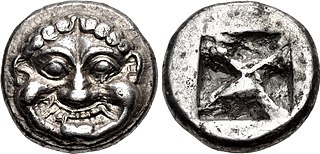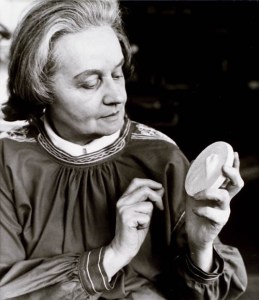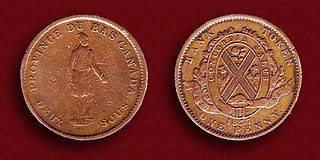Related Research Articles

A coin is a small object, usually round and flat, used primarily as a medium of exchange or legal tender. They are standardized in weight, and produced in large quantities at a mint in order to facilitate trade. They are most often issued by a government. Coins often have images, numerals, or text on them. The faces of coins or medals are sometimes called the obverse and the reverse, referring to the front and back sides, respectively. The obverse of a coin is commonly called heads, because it often depicts the head of a prominent person, and the reverse is known as tails.

The Royal Canadian Mint is the mint of Canada and a Crown corporation, operating under the Royal Canadian Mint Act. The shares of the Mint are held in trust for the Crown in right of Canada.

The history of ancient Greek coinage can be divided into four periods: the Archaic, the Classical, the Hellenistic and the Roman. The Archaic period extends from the introduction of coinage to the Greek world during the 7th century BC until the Persian Wars in about 480 BC. The Classical period then began, and lasted until the conquests of Alexander the Great in about 330 BC, which began the Hellenistic period, extending until the Roman absorption of the Greek world in the 1st century BC. The Greek cities continued to produce their own coins for several more centuries under Roman rule. The coins produced during this period are called Roman provincial coins or Greek Imperial Coins.

A mint is an industrial facility which manufactures coins that can be used as currency.

The Coinage of India began anywhere between early 1st millennium BCE to the 6th century BCE, and consisted mainly of copper and silver coins in its initial stage. The coins of this period were Karshapanas or Pana. A variety of earliest Indian coins, however, unlike those circulated in West Asia, were stamped bars of metal, suggesting that the innovation of stamped currency was added to a pre-existing form of token currency which had already been present in the Janapadas and Mahajanapada kingdoms of the Early historic India. The kingdoms that minted their own coins included Gandhara, Kuntala, Kuru, Magadha, Panchala, Shakya, Surasena, Surashtra and Vidarbha etc.
This glossary of numismatics is a list of definitions of terms and concepts relevant to numismatics and coin collecting, as well as sub-fields and related disciplines, with concise explanations for the beginner or professional.

The Magdalen Island penny token was a token that was originally issued for use on that island and throughout Lower Canada and the Maritime Provinces in the early 19th century. This token was issued in 1815 by Sir Isaac Coffin, who was granted the island by the British government in reward for his loyalty to the crown during the American Revolutionary War. While not a rare coin, it is hard to find in anything but worn condition, and even prices for pieces in the lowest grades tend to start at about at about C$100 and go up rapidly from there.
By 1954, a new trend was beginning to emerge for the Royal Canadian Numismatic Association as annual meetings evolved into annual conventions. Working with the Toronto Coin Club as host, the first such convention was held in Toronto in 1954. The conventions offered an agenda of educational forums, bourse activity, competitive exhibits with awards to the winners, and a closing banquet, with the highlight being a special guest speaker.. It was also in 1954 that the association issued its first ever medal to commemorate the event. The tradition of an annual convention and a convention medal continues to this very day.
The Canadian silver dollar was first issued by the Royal Canadian Mint in 1935 to commemorate the Silver Jubilee of King George V. The coin's reverse design was sculpted by Emanuel Hahn and portrays a voyageur and a person of Indigenous descent paddling a birch-bark canoe. The faint lines in the background represent the Northern Lights. The voyageur design was used on the dollar until 1986. It was then replaced with the 1987 Canadian 1-dollar coin. 1967 marked the end of the silver dollar as a business strike, or a coin issued for circulation. After 1967, the dollar coin was made of nickel, except for non-circulating commemorative issues for the collector market, which continue to contain silver.
Jerome "Jerry" Hosmer Remick III was a Canadian numismatist, geologist and columnist for Canadian Coin News.
One of the most highly profitable aspects of the Royal Canadian Mint's enterprise is in its Numismatic product line. The euphoria surrounding the year 2000 led to the birth of the Millennium 25-cent coin program. The numismatic line included proof quality coins sold individually or as a complete set. This level of excess would come to signify the coming decade. The number of numismatic releases would increase on an annual basis starting in 2003. Numismatic three cents, five cents, and ten cents would be introduced, along with numismatic three dollars and eight dollars. Luxury coins would not be immune to the dramatic increases that ensued. Coins with face values of 250, 300 and 350 dollars would be introduced by 2006.
Yvon Gariepy was the President of the Royal Canadian Mint from 1975 to 1981. In later years, he worked for Canada Post. Mr. Gariepy was a professional member of the Order of Engineers of Quebec, Professional Corporation of Urbanists of Quebec, Canadian Institute of Planners and the Institute of the Public Administration of Canada.
Starting in 1997, the Royal Canadian Mint started to sell hockey medallions to the public. To commemorate the induction of Mario Lemieux in the Hockey Hall of Fame, a set was issued honouring all three inductees. One set was issued in Sterling Silver while another was issued in Nickel. The success of the release led to future issues.

Dora de Pédery-Hunt, LL.D. was a Hungarian-Canadian sculptor who designed medals and coins. She was the first Canadian citizen to design an effigy for Queen Elizabeth II.

The Bank of Canada Museum, formerly known as the Currency Museum, opened in 1980 on the ground floor of the Bank of Canada building in Ottawa, Ontario, Canada. Temporarily closed in 2013 for major building renovations, the museum reopened in a new space on July 1, 2017, in a new building, with a completely new design and concept. It is, however, connected to the main building through the Bank of Canada's underground conference centre.

Punch-marked coins, also known as Aahat coins, are a type of early coinage of India, dating to between about the 6th and 2nd centuries BC. It was of irregular shape. These coins are found over most parts of subcontinent and remained in circulation till the early centuries CE.

The Habitant token were a series of tokens that were created for use primarily within Lower Canada and were issued in 1837. Produced as a successor to the popular bouquet sous, these tokens depicted a Habitant on the obverse, a traditional depiction of a French-Canadian farmer in winter clothing, and the coat of arms for the City of Montreal on the reverse. The tokens were issued in both one penny/deux sous and half penny/un sou denominations by the leading commercial banks of Montreal. They were issued in large numbers and can be easily acquired by the modern collector, though some varieties are rare and command a premium.

The Jubilee coinage or Jubilee head coinage are British coins with an obverse featuring a depiction of Queen Victoria by Joseph Edgar Boehm. The design was placed on the silver and gold circulating coinage beginning in 1887, and on the Maundy coinage beginning in 1888. The depiction of Victoria wearing a crown that was seen as too small was widely mocked, and was replaced in 1893. The series saw the entire issuance of the double florin (1887–1890) and, in 1888, the last issue for circulation of the groat, or fourpence piece, although it was intended for use in British Guiana. No bronze coins were struck with the Jubilee design.

The Bust and Harp tokens were tokens originally issued anonymously in the mid-1820s, and circulated primarily in Lower Canada. Due to their anonymous nature, it is not known who placed the order for the original tokens, but they are believed to have been minted in England beginning in 1825. The initial release of the tokens was dated 1825, but a currency regulation issued that same year made the importation of privately issued tokens illegal. As a result, the initial issue was altered and all subsequent issues of these tokens were antedated to 1820 in order to get around this prohibition, which did not prohibit tokens made before this date. They were circulated in large quantities and were widely imitated by minters located in Canada, making for many varieties. Those of particularly poor craftsmanship are considered examples of Blacksmith tokens. They were roughly the size of a contemporaneous half-penny, though generally weighed less. They were widely circulated in Lower Canada for at least 30 years, after which banks began to refuse them as payment except by weight. The more common Bust and Harp tokens can be had for about a few tens of C$, though rarer varieties can command prices in the thousands of dollars.
References
- ↑ Billing, Archibald (1875). The Science of Gems, Jewels, Coins, and Medals, Ancient and Modern. Daldy & Hill. p. 94. Retrieved 18 June 2018.
- ↑ Mechanic's Magazine, Museum, Register, Journal & Gazette. Knight and Lacey. 1834. p. 188.
- ↑ Salzano, Tammi (2009). Deluxe Canadian coin collecting album. Scholastic Canada. p. 33. ISBN 9780545177399.
- ↑ Courtney, Yolanda C. S.; Britain), Royal Numismatic Society (Great (2004). Public house tokens in England and Wales c.1830-c.1920. Royal Numismatic Society. p. 117. ISBN 9780901405784.